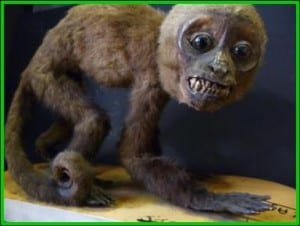Specimen of the Week: Week Thirty-Nine
By Emma-Louise Nicholls, on 9 July 2012
 On occasion we get people phoning us at the Grant Museum of Zoology to ask what kind of museum we are. To some, a sarcastic response may spring to mind in a witty yet placating explanation of the word ‘zoology’, but on closer inspection of the question, one realises that what they are actually asking, is what kind of zoological things we have here. I explain that we are an apple pie of fluid specimens with a generous helping of skeleton flavoured ice-cream, topped with just a sprinkle of taxidermy hundreds and thousands (as in the small chocolatey things, we don’t actually have hundreds and thousands of taxidermy specimens). Taxidermy specimens provide an excellent foray into history and the local zoological knowledge at the time of the ‘stuffing’. I have seen many a specimen in which the taxidermist clearly had no idea of what the animal his/her current empty skin project was supposed to look like. But they form a part of history in themselves. And for ‘good’ taxidermy, they at the very least, provide an aesthetic exhibit. So I’d like to introduce you to one. This week’s specimen of the week is…
On occasion we get people phoning us at the Grant Museum of Zoology to ask what kind of museum we are. To some, a sarcastic response may spring to mind in a witty yet placating explanation of the word ‘zoology’, but on closer inspection of the question, one realises that what they are actually asking, is what kind of zoological things we have here. I explain that we are an apple pie of fluid specimens with a generous helping of skeleton flavoured ice-cream, topped with just a sprinkle of taxidermy hundreds and thousands (as in the small chocolatey things, we don’t actually have hundreds and thousands of taxidermy specimens). Taxidermy specimens provide an excellent foray into history and the local zoological knowledge at the time of the ‘stuffing’. I have seen many a specimen in which the taxidermist clearly had no idea of what the animal his/her current empty skin project was supposed to look like. But they form a part of history in themselves. And for ‘good’ taxidermy, they at the very least, provide an aesthetic exhibit. So I’d like to introduce you to one. This week’s specimen of the week is…
**!!!The Chimpanzee!!!**
1) There is only one species of chimpanzee, not to be confused with the bonobo which is the same genus, but a different species. There are however, four subspecies based on both morphology and geography; the western or masked chimp, the central or black-faced chimp, the eastern or long-haired chimp, and the eastern Nigeria chimp (they only get the one name). Every subspecies shares the long arms and lack of hair on the face, ears, palms, and soles of the feet.
2) Although chimps primarily dine on fruit, they are excellent hunters and will co-ordinate themselves as a troop to catch and kill monkeys. In times when food is scarce, chimps will supplement their diet with flowers, leaves, seeds and insects. I tried a fried cricket in Mexico once, I don’t recommend it. I also ate a fly at a barbeque last summer, but that was an accident.
3) Although nowhere near as impressive as gibbons when it comes to tree swinging, chimps have longer arms than legs and more mobile shoulder joints than humans. Despite their size and weight, they can therefore zoom about in trees with ease, in which they both relax, and forage for food. On the ground, they act more like gorillas, and take to walking on their knuckles.
4) Besides habitat destruction (via slash and burn agriculture, plus logging, and oil and gas mining), and poaching (for meat, the pet trade, ”medicinal’ purposes, and snares/crop-protection), disease is a main cause of population decline amongst wild chimpanzees. Unfortunately for chimps, they are close enough to humans, both genetically and geographically, to catch many of our diseases. Unable to pop along to the doctor (I took a capuchin monkey to a hospital in Ecuador for emergency care once, it’s hard work getting taken seriously), chimps are more likely to succumb to these illnesses. For example, chimp populations in Côte d’Ivoire, Gabon and areas of the Democratic Republic of Congo, have dramatically decreased within the last 15 years due to the Ebola virus.
5) We like to think we are pretty clever as a species but not only do chimps exhibit tool-use, just like us, they do not use this skill to destroy the planet. Who’s the more clever ape? They have invented fly wisps, nutcrackers, and even fishing rods to extract ants from small holes. So really they should be called anting rods. Though it crops up in seemingly random places such as sponge crabs and lammergeier vultures, tool use is not common and even in primates, very few species exhibit it.
One Response to “Specimen of the Week: Week Thirty-Nine”
- 1
 Close
Close





[…] specimens in need range in size from a chimpanzee to a pink fairy armadillo, and include platypuses, a koala, a turtle and a pangolin. Given the […]